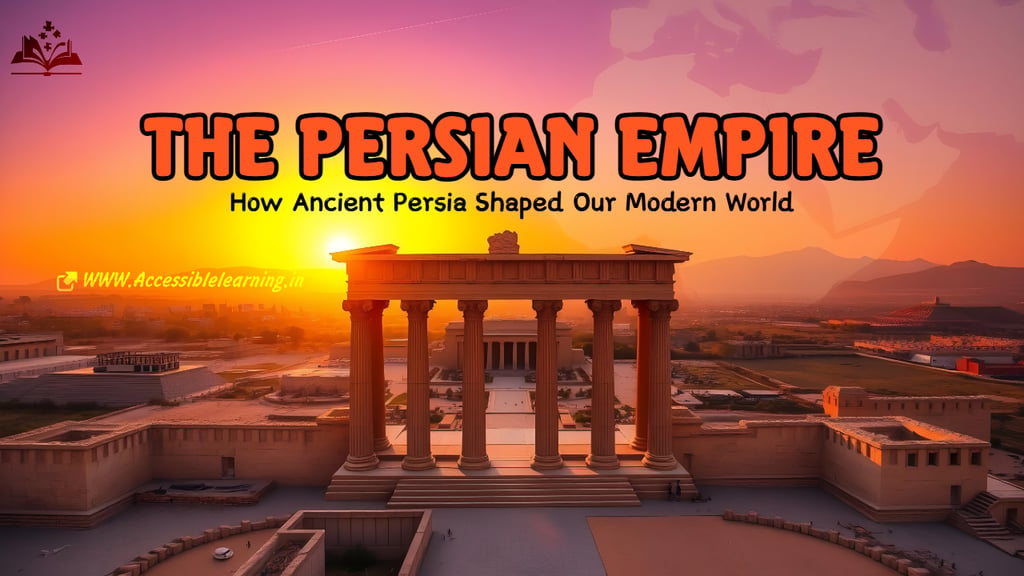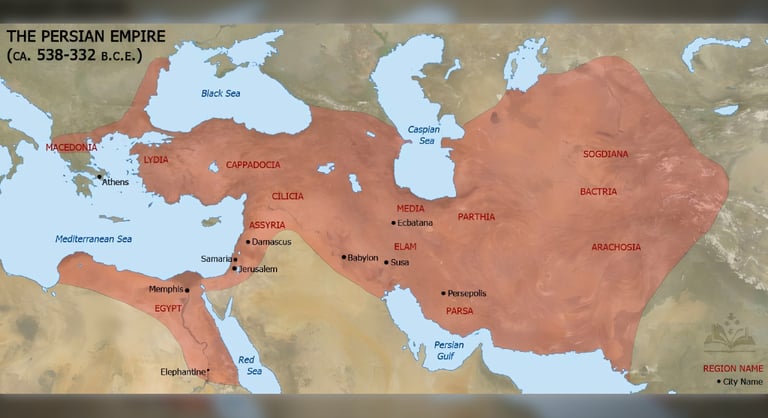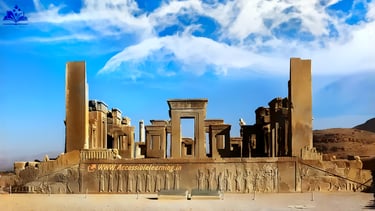
The Persian Empire: How Ancient Persia Shaped Our Modern World
Discover the extraordinary legacy of the Persian Empire, from Cyrus the Great's revolutionary leadership to the enduring impact of Persian innovations on global civilization. This comprehensive guide explores the political achievements, cultural advances, and historical significance of one of antiquity's most influential empires.
HISTORYEDUCATION/KNOWLEDGEHARSH REALITY
Keshv Jha
3/19/202510 min read


The Persian Empire stands as one of history's most influential civilizations, stretching at its peak from the Indus Valley to the Mediterranean Sea and from Central Asia to Egypt. Founded by Cyrus the Great in 550 BCE, this remarkable empire introduced innovations in governance, infrastructure, and cultural tolerance that would influence civilizations for millennia to come. This article explores the rich tapestry of Persian history, from its humble beginnings to its lasting impact on our modern world.
The Pre-Achaemenid Era: Foundations of Persian Civilization
Before the rise of the Persian Empire, the Iranian plateau was home to various Indo-European peoples who migrated to the region around 1500 BCE. These early settlers developed agricultural societies in a challenging environment characterized by mountain ranges, desert plains, and limited water sources.
By the 9th century BCE, the region was divided primarily between two groups:
The Medes in the north, who established a kingdom with its capital at Ecbatana (modern Hamadan),
The Persians in the south, centered around Anshan in the Zagros mountains
These proto-Iranian peoples shared linguistic and cultural similarities, worshipping early forms of what would become Zoroastrianism and developing distinctive artistic styles. For a time, the Medes dominated the political landscape, even participating in the defeat of the powerful Assyrian Empire in 612 BCE alongside the Babylonians.
This pre-imperial period established crucial foundations—including horsemanship, metallurgy, and early administrative systems—that would later enable the Persians to build their vast empire.
The Rise of Persia: Cyrus the Great and the Achaemenid Dynasty
The story of the Persian Empire begins with Cyrus II, later known as Cyrus the Great. Born around 600 BCE, Cyrus unified the Persian tribes and overthrew the Median Empire in 550 BCE, establishing what would become the Achaemenid Dynasty—the first Persian Empire.
Cyrus's military genius enabled him to conquer Babylon in 539 BCE without significant bloodshed. Rather than ruling as a tyrant, he implemented a revolutionary approach to governance. The Cyrus Cylinder, discovered in 1879, documents his policy of religious tolerance and respect for local customs—an unprecedented approach in ancient times. Some scholars consider it an early human rights charter, though this interpretation remains debated.
Cyrus also famously freed the Jewish people from Babylonian captivity, allowing them to return to Jerusalem and rebuild their temple. This act earned him the distinction of being the only non-Jewish figure in the Hebrew Bible to be called "messiah" or "anointed one."
Under Cyrus's rule, conquered peoples maintained their cultural identities while enjoying the benefits of Persian administration. This strategic approach to empire-building created remarkable stability and loyalty throughout the diverse territories.
Darius I and the Golden Age
After Cyrus's death in 530 BCE, his son Cambyses II briefly ruled before Darius I (ruled 522-486 BCE) took the throne, ushering in what many historians consider the golden age of the Persian Empire.
Darius implemented several transformative initiatives:
A sophisticated provincial system with local governors (satraps) who maintained order and collected taxes
A standardized taxation system based on careful assessment of each province's productive capacity
A unified legal code that respected local traditions while establishing imperial standards
The construction of the Royal Road—a 1,500-mile highway facilitating communication and trade
A postal service that, according to the Greek historian Herodotus, "neither snow nor rain nor heat nor darkness of night prevents from accomplishing their appointed course with all speed."
The introduction of a standardized coinage system using gold darics and silver sigloi
Darius also initiated the construction of Persepolis ("city of Persians"), a magnificent ceremonial capital showcasing the empire's tremendous wealth and artistic achievements. The ruins of Persepolis remain one of the world's most impressive archaeological sites today.
The administrative genius of Darius cannot be overstated. His reorganization of the empire into 20 satrapies (provinces), each with clear tax obligations and administrative structures, created unprecedented stability. Regular inspections by royal officials known as "the king's eyes and ears" helped prevent corruption and rebellion.


Economic Systems and Trade Networks
The Persian Empire developed sophisticated economic systems that facilitated trade across its vast territories:
Currency and Taxation
Darius I standardized currency with the introduction of gold darics and silver sigloi, facilitating commerce throughout the empire. The consistent weight and purity of these coins made them trusted throughout the Mediterranean world.
The taxation system was remarkably sophisticated, with each province assessed based on its agricultural productivity and economic capabilities. Tax collection was systematic but generally fair by ancient standards, with records kept in imperial archives.
Trade Routes and Commodities
The Persian Empire controlled crucial trade routes connecting East and West:
The Royal Road from Susa to Sardis enabled rapid transport of goods and communication
Maritime routes through the Persian Gulf connected Mesopotamia to India
Caravan routes across Central Asia facilitated early Silk Road trade
Major trade commodities included:
Textiles, particularly fine wool and cotton
Precious metals, especially gold from Lydia and silver from various provinces
Cedar wood from Lebanon
Spices from India
Lapis lazuli from Afghanistan
Ivory from Africa and India
The empire's vast size and diverse ecosystems meant that a remarkable variety of goods flowed through Persian markets, creating cosmopolitan urban centers where merchants from distant lands conducted business.
Persian Military Campaigns and Encounters with Greece
The Persian Empire's expansion inevitably brought it into conflict with the Greek city-states. Darius I sent expeditions to secure the western boundaries of his empire, culminating in the Battle of Marathon in 490 BCE, where Athenian forces repelled the Persian advance.
His son Xerxes I (ruled 486-465 BCE) launched a massive invasion of Greece in 480 BCE, temporarily capturing Athens. However, naval defeats at Salamis and subsequent battlefield losses at Plataea and Mycale forced Persian withdrawal. Despite these setbacks, the empire remained incredibly powerful and prosperous.
The Immortals: Elite Persian Warriors
The Persian military included a corps of 10,000 elite soldiers known as the Immortals because their numbers were always maintained—when one fell, another immediately took his place. These warriors, equipped with the finest weapons and distinctive scaled armor, formed the core of the Persian royal guard and served as the empire's primary shock troops.
The Persian military was remarkably diverse, drawing soldiers from across the empire's many peoples. This diversity provided tactical flexibility but sometimes created challenges in command and coordination. Cavalry units, particularly those from the Iranian plateau, were considered among the finest in the ancient world.
Persian Culture, Religion, and Society
Religion and Philosophy
Zoroastrianism, founded by the prophet Zoroaster (Zarathustra), became the predominant religion of ancient Persia. This faith introduced revolutionary concepts, including:
Monotheism centered around Ahura Mazda, the wise lord
The cosmic struggle between truth (asha) and falsehood (druj)
Personal moral responsibility
Belief in heaven, hell, and final judgment
The importance of "good thoughts, good words, good deeds"
The sacred text of Zoroastrianism, the Avesta, includes hymns (Gathas) attributed to Zoroaster himself and detailed ritual instructions. Fire temples became central to Zoroastrian worship, with eternal flames symbolizing the divine presence.
These concepts would later influence Judaism, Christianity, and Islam. Notably, the Persian Empire practiced religious tolerance, allowing conquered peoples to maintain their traditional worship practices.
Social Structure and Daily Life
Persian society was hierarchical but relatively fluid compared to some ancient civilizations.
The royal family and nobility occupied the highest positions, owning vast estates
A professional class of administrators, scribes, and military officers formed a middle tier
Merchants and artisans constituted a prosperous urban class
Farmers and peasants formed the majority of the population
Slaves existed but had certain protections under Persian law
Women in Persian society enjoyed relatively higher status than in many contemporary civilizations. Royal and noble women owned property, managed estates, and sometimes influenced politics. The queen mother often wielded considerable power at court.
Everyday life for Persians included:
A diet based on bread, rice, fruits, and meat when available
Clothing made primarily of wool and linen, with elaborate fashions for the wealthy
Education focused on physical training, archery, horsemanship, and for nobles, literacy
A strong emphasis on truthfulness as a moral virtue
Art and Architecture
Persian art blended elements from various cultures within their empire while developing distinctive styles:
Monumental stone reliefs depicting royal ceremonies and tributes
Intricately carved columns with animal motifs
Elaborate metalwork, including the famous gold and silver rhytons (drinking vessels)
Exquisite carpet weaving traditions that continue today
Fine glazed brickwork, particularly in blue and gold
Delicate jewelry incorporating granulation techniques
Persian architectural innovations included hypostyle halls with towering columns, elaborate gardens with irrigation systems (paradise gardens), and domed structures that would later influence Byzantine and Islamic architecture.
Persepolis exemplified Persian architectural achievement, featuring:
The Apadana (audience hall) with 72 columns, each 19 meters tall
The Gate of All Nations with massive bull-shaped capitals
The Treasury and royal apartments
Elaborate drainage systems and water features
These architectural achievements relied on sophisticated engineering knowledge and the ability to transport massive stone blocks over great distances.
Science and Innovation
The Persian Empire fostered scientific advancement.
Advanced irrigation systems, including underground aqueducts called qanats that transported water from aquifers to settlements
Sophisticated mathematics, including early work on algebra and trigonometry
Early astronomical observations used for calendar systems and navigation
Medical knowledge preserved in extensive libraries, particularly at Gundeshapur
Horticultural innovations, including the development of new fruit varieties through grafting
The Persian educational system emphasized practical knowledge alongside traditional subjects, producing engineers, administrators, and military leaders capable of managing a complex empire.


The Later Persian Empires
The Achaemenid Empire eventually fell to Alexander the Great in 330 BCE, but Persian civilization continued through subsequent dynasties:
The Seleucid Interlude
After Alexander's death, his general Seleucus gained control of much of the former Persian territories, establishing the Seleucid Empire (312–63 BCE). This Hellenistic kingdom represented a fusion of Greek and Persian elements, with Greek political institutions overlaid on Persian administrative structures.
While Greek culture influenced urban centers, traditional Persian culture and Zoroastrianism persisted throughout the countryside. This period saw the beginning of significant cultural exchange between Eastern and Western traditions.
The Parthian Empire (247 BCE-224 CE)
The Parthians, originally a nomadic people from Central Asia, established a powerful empire that served as Rome's primary eastern rival. Their military innovations included highly mobile mounted archers—the famous "Parthian shot," executed by horsemen shooting backward while retreating.
Parthian society represented a blend of Hellenistic influences and Iranian traditions, with a decentralized political structure where powerful noble families maintained significant autonomy. The Parthians revived many Persian traditions and actively promoted Zoroastrian religion.
Major achievements of the Parthian era included:
Sophisticated urban planning, especially at their capital of Ctesiphon
Complex defensive architecture, including innovative use of arches
Revival of Persian artistic traditions
Maintenance of crucial trade routes connecting East and West
The Parthians successfully resisted Roman expansion eastward, defeating several major Roman invasions and maintaining control of the lucrative Silk Road trade.
The Sassanid Empire (224-651 CE)
The Sassanids overthrew the Parthians and established a more centralized state explicitly focused on reviving Achaemenid traditions. Their founder, Ardashir I, claimed descent from the ancient Persian kings and sought to restore Persian glory.
The Sassanid era represented another golden age of Persian culture, with advancements in:
Distinctive architectural styles featuring massive barrel-vaulted iwans (arched halls)
Scientific and mathematical knowledge, particularly at the academy of Gundeshapur
Literary developments, including the codification of Zoroastrian religious texts
Administrative systems that would later influence Islamic governance
Revolutionary military technology, including heavy cataphracts (armored cavalry),
Sophisticated textile production, particularly silk brocades
Musical theory that influenced later Islamic and European traditions
The Sassanids engaged in near-constant warfare with the Byzantine Empire, eventually weakening both powers. This mutual exhaustion contributed to the rapid Arab Muslim conquest of Persia in the 7th century.
Islamic Persia: Continuity Through Transformation
The Arab conquest of Persia in 651 CE marked the end of pre-Islamic Persian empires, but Persian culture proved remarkably resilient. After initial resistance, Persians gradually converted to Islam while maintaining distinct cultural identity.
The Iranian Renaissance
By the 9th and 10th centuries, a remarkable cultural revival occurred under dynasties like the Samanids, who promoted Persian language and literature while maintaining Islamic faith. This period saw:
The composition of the Shahnameh (Book of Kings) by Ferdowsi, a monumental epic preserving ancient Persian legends
The development of New Persian (Farsi) written in Arabic script
Major scientific advances by Persian scholars like Avicenna (Ibn Sina) and al-Biruni
The establishment of distinctive Persian-Islamic architectural styles
Medieval Persian Empires
Several important medieval empires maintained Persian cultural traditions:
The Buyids (934-1062) revived elements of Sassanid administrative practices
The Seljuks (1037-1194) blended Turkish military prowess with Persian administrative expertise
The Khwarazmian Empire (1077-1231) controlled vast territories before falling to Genghis Khan
Even after the devastating Mongol invasions, Persian culture survived and influenced the invaders. The Ilkhanate established by Hulagu Khan quickly adopted Persian administrative practices and cultural elements.
Legacy and Modern Relevance
The Persian Empire's influence extends far beyond its timeframe:
Administrative innovations that informed later empires' governance structures
Religious concepts that influenced major world religions
Architectural elements adopted throughout the Middle East and beyond
Cultural traditions that continue in modern Iran and Central Asia
Linguistic legacy in the Indo-Iranian language family
Literary traditions that produced works like the Shahnameh, Rubaiyat of Omar Khayyam, and poetry of Hafez and Rumi
Scientific contributions preserved in Arabic and Latin translations that influenced European Renaissance
Philosophical concepts explored by scholars like Avicenna that shaped Islamic and Christian thought
Despite its eventual fall, Persia's cultural identity persisted through Islamic rule. The 16th-century Safavid Dynasty revived Persian culture, creating another flourishing period of Persian art, architecture, and literature.
Archaeological Discoveries and Modern Research
Modern archaeological research continues to reveal new insights about the Persian Empire:
Excavations at Persepolis, begun in the 1930s by Ernst Herzfeld and continued by various teams, have revealed detailed information about imperial architecture and administrative practices
The discovery of the Persepolis Fortification Archive, containing thousands of administrative tablets, has provided unprecedented insight into daily operations of the empire
Underwater archaeology in the Persian Gulf has revealed ancient trading networks
Satellite imagery has identified previously unknown settlements and road networks
DNA analysis of ancient remains is providing new information about population movements and relationships
These discoveries have transformed our understanding of the Persian Empire, moving beyond Greek historical accounts to develop a more balanced perspective on this remarkable civilization.


The Persian Empire represents one of humanity's most remarkable civilizational achievements. From Cyrus's innovative governance approaches to the artistic splendors of Persepolis, Persian contributions to human development remain significant. Their administrative systems, religious tolerance, architectural innovations, and cultural achievements established a legacy that continues to influence our world today.
By studying the Persian Empire, we gain valuable insights into effective governance, cultural integration, and the power of tolerance—lessons that remain relevant in our modern global society. The story of ancient Persia reminds us that truly successful civilizations combine military strength with cultural sophistication, technological innovation, and respect for diversity.
The Persian legacy lives on not only in modern Iran but in fundamental concepts of governance, religious thought, artistic expression, and scientific inquiry that have shaped global civilization. As archaeological discoveries and historical research continue to reveal new aspects of this remarkable civilization, our appreciation for the Persian achievement only grows deeper.
Subscribe To Our Newsletter
All © Copyright reserved by Accessible-Learning Hub
| Terms & Conditions
Knowledge is power. Learn with Us. 📚


